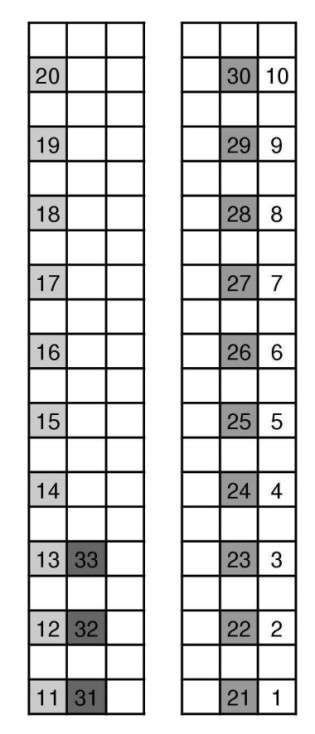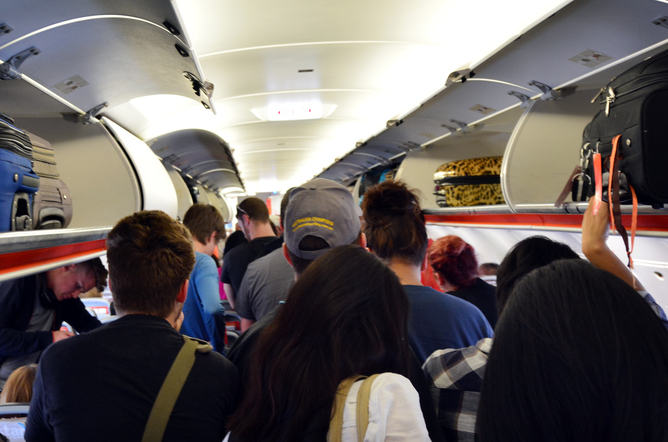Why It Takes So Long to Board an Airplane (And How to Fix It)
Well, maybe it does. Enter Jason Steffen, an astrophysicist at the Fermilab Center for Astrophysics outside of Chicago. Steffen, in his own words, “had been thinking about this problem for two or three years and decided that [he] needed to either satisfy [his] curiosity or forget about it.” He opted for the former. Through his mental field trips, he deduced that the “people standing in the aisle of the airplane are just standing in line” and that “loading back to front just moves the line inside the plane” instead of shuffling the bodies into seats more quickly. By loading the planes the way airlines were, nothing was being accomplished — everyone was still getting in everyone else’s way.
Steffen developed a simulation to try and find a way around this. Wired explains:
He started experimenting with rearranging the line by seat number. He ran his simulation ran over and over, and each time it switched the boarding order of two random passengers: If the plane boarded faster, it kept the switch. If the plane boarded more slowly, it switched them back. Then, the program ran again, switching another random pair. And again. And again. Each time, it moved closer to the optimal boarding order.
Eventually, a pattern emerged — one which loads passengers into the plane back to front, but in a zipper-style formation, as seen in his diagram, below.

By leaving space around each person as he or she boards, there is less competition for the aisle space and for the overhead bins. And by loading people window-to-aisle, there’s less chance of an already seated person being in the way.
Does it work? Yes — at least in a controlled environment. In 2013, the TV show “This vs. That” took a look at five alternative methods to board a plane, including the Steffen Method. As seen in the video here, the Steffen Method performed very well, beating the competition easily. While the back-to-front method takes about 6 minutes or more to get everyone on board, the Steffen Method takes about half that.
Dr. Steffen believes this time savings could lead to a significant cost savings, but unfortunately, none of the commercial airlines seem to want to adopt it. As Inc. noted, Steffen’s model “may be a little too theoretical for reality” — it requires a strict ordering of each of the passengers (and, during boarding, the temporary separation of groups), something that many travelers may not take kindly to. So for now, be prepared to be frustrated as you make your way to your seating assignment.
 Bonus Fact: The Federal Aviation Administration, which regulates everything to do with air travel, allows children under the age of two to fly without a seat — they can ride on their parents’ laps. The American Academy of Pediatrics isn’t a fan of the policy, recommending that “families explore options to ensure that each child has her own seat,” even suggesting that parents “try to select a flight that is likely to have empty seats where your child could ride buckled in her car safety seat.” The National Transportation Safety Board agrees with the AAP, advocating for rules requiring that children under the age of two “be restrained by an appropriate child restraint system during air travel.” So why does the FAA allow what appears to be an unsafe practice? Safety! In 2005, the FAA announced that, according to a study the agency undertook, “if forced to purchase an extra airline ticket [for children under 2], families might choose to drive, a statistically more dangerous way to travel.”
Bonus Fact: The Federal Aviation Administration, which regulates everything to do with air travel, allows children under the age of two to fly without a seat — they can ride on their parents’ laps. The American Academy of Pediatrics isn’t a fan of the policy, recommending that “families explore options to ensure that each child has her own seat,” even suggesting that parents “try to select a flight that is likely to have empty seats where your child could ride buckled in her car safety seat.” The National Transportation Safety Board agrees with the AAP, advocating for rules requiring that children under the age of two “be restrained by an appropriate child restraint system during air travel.” So why does the FAA allow what appears to be an unsafe practice? Safety! In 2005, the FAA announced that, according to a study the agency undertook, “if forced to purchase an extra airline ticket [for children under 2], families might choose to drive, a statistically more dangerous way to travel.”
From the Archives: Can’t Hardly Wait: We really hate standing in lines — so much so that organizations (like airports) try and make us feel like we’re not (even when we are.)
Take the Quiz: Which airline dominates which airport?
Related: “Blue Streak: Inside jetBlue, the Upstart that Rocked an Industry” by Barbara Peterson. 4.4 stars on 25 reviews.

